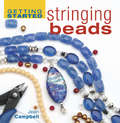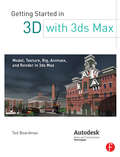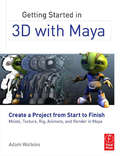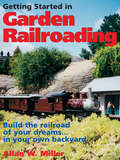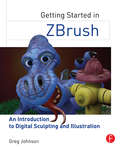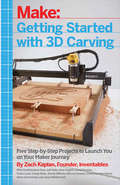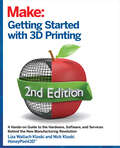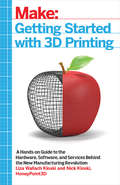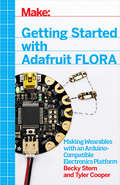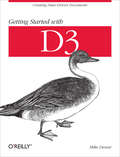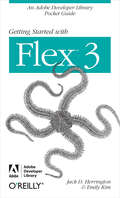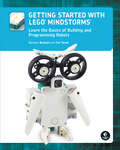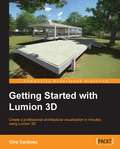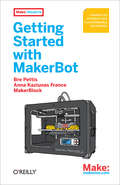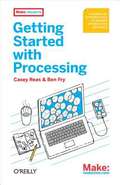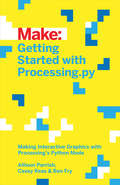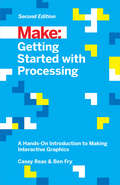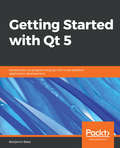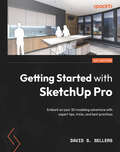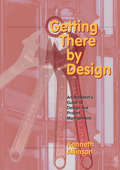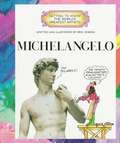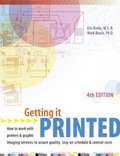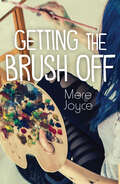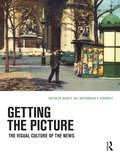- Table View
- List View
Getting Started Stringing Beads (Getting Started Ser.)
by Jean CampbellThe art of crafting beautiful string and bead creations is explained in this step-by-step guide for novice beaders. Everything the beginner needs to know, including information on selecting the appropriate beads at the store and a complete guide to basic stringing materials are provided, along with pointers on securing beading wires with crimps, tying knots, and working with findings. Twenty-five quick and simple projects will help build foundational technical skills and result in exciting bead creations such as charm bracelets and chandelier earrings. This resource guide gives readers the skills to create their own pieces.
Getting Started in 3D with 3ds Max: Model, Texture, Rig, Animate, and Render in 3ds Max
by Ted BoardmanLearning a 3D visualization software is a daunting task under any circumstances and while it may be easy to find online tutorials that tell you what to do to perform certain tasks you'll seldom learn "why" you are performing the steps. This book approaches training from a top-down perspective way you will first learn important concepts of 3D visualization and functionality of 3ds Max before moving into the finer detail of the command structure. By learning how things work and why you might choose one method over another the book will not only teach you where the buttons are, but more importantly how to think about the holistic process of 3D design so that you can then apply the lessons to your own needs. The goal of the learning presented here is to familiarize the new user of 3ds Max with a typical workflow from a production environment from planning to modeling, materials, and lighting, and then applying special effects and compositing techniques for a finished product.
Getting Started in 3D with Maya: Create a Project from Start to Finish—Model, Texture, Rig, Animate, and Render in Maya
by Adam WatkinsDeliver professional-level 3D content in no time with this comprehensive guide to 3D animation with Maya. With over 12 years of training experience, plus several award winning students under his belt, author Adam Watkins is the ideal mentor to get you up to speed with 3D in Maya. Using a structured and pragmatic approach Getting Started in 3D with Maya begins with basic theory of fundamental techniques, then builds on this knowledge using practical examples and projects to put your new skills to the test. Prepared so that you can learn in an organic fashion, each chapter builds on the knowledge gained in the previous chapter, showing you all the essentials of 3D in Maya, from modeling and UV layout, to texture creation, rigging animating and rendering. As you go from project to project you'll develop a strong arsenal of skills that combined will form a complete end to end process to creating complete projects in Maya. The accompanying website provides all the tools you need to develop your skills. Project files to accompany the practical examples used throughout the text, so you can work along with the examples. Additional textures and models will give you all the resources you need to start making your own projects in no time at all.
Getting Started in Garden Railroading: Build the railroad of your dreams#in your own backyard!
by Allan W. MillerGetting Started in Garden Railroading Here's your invitation to get started in a great hobby that's fun for the entire family. Large Scale trains are big, rugged, durable, and colorful - designed for safe and reliable operations both indoors and outdoors. When you combine model railroading with the real-life environment of a vibrant, growing garden, you'll discover a whole new world of creative opportunities, challenges, and enjoyment to fill your all-important leisure hours. This book provides all the step-by-step guidance needed to get started in this fascinating pastime. Among other things, you'll find: Details of procedures for planning, constructing, powering, landscaping, operating, and maintaining a complete garden railroad. More than 200 full-color photos of products construction techniques, and inspiring examples of what can actually be achieved in garden railroading. The most comprehensive listings of manufactures, suppliers, clubs, publications, print and video references, and Internet Web site addresses ever published in a model railroading handbook. Answers to the most frequently asked questions about what it takes to get started in this diverse and affordable hobby. Tips and techniques provide by experienced garden railroaders from around the world. Garden railroading: A great hobby for all seasons, and for all the right reasons!
Getting Started in ZBrush: An Introduction to Digital Sculpting and Illustration
by Greg JohnsonGetting Started in ZBrush is a gentle introduction to ZBrush, today’s premier digital sculpting program. Beginning with the fundamentals of digital sculpting as well as a thorough introduction to the user interface, Getting Started in ZBrush will have you creating a variety of professional-level 3D models in no-time. More than just another button-pushing manual, this comprehensive guide is packed with start-to-finish projects that ease you into the workflow of the program, while at the same time providing tips and tricks that will allow you to achieve certain tasks much more quickly. After progressing through the tutorials, you will be shown how to customize brushes, materials, scripts, and the interface so that you can utilize these tools to their full advantage. Special consideration is given to ZBrush’s integration plug-ins with Maya and 3ds Max, allowing you to properly import and export your models in all programs. Texturing, painting, mapping, decimation, baking, and topology are also fully covered so your Zbrush creations can come to life without sacrificing that high-resolution look. Ease your way into this complex subject with this straight-forward approach to ZBrush Perfect your technique with step-by-step tutorials that allow you to create high res models from start to finish. Expand your knowledge by visiting the companion website, which features video demonstrations, project files, texture and model files, scripts, customized menus, brushes, and additional resources.
Getting Started with 3D Carving: Five Step-by-Step Projects to Launch You on Your Maker Journey
by Zach Kaplan3D printing has been the hot topic in the maker world for years now, but there's another type of desktop manufacturing that's become the go-to choice for anyone who needs durable results fast. Instead of slowly depositing layers of plastic, a 3D carver starts with a solid block of material and carves it away using a rotating metal bit. It's faster than 3D printing, offers a wider choice of materials, and creates durable, permanent parts that look great. This book covers the basics of designing and making things with a 3D carver, and gives you several projects you can build yourself including a guitar, clock, earrings, and even a skateboard.
Getting Started with 3D Printing
by Liza Wallach Kloski Nick KloskiThe book is written in a casual, conversational style. It is easily accessible to those who have no prior knowledge in 3D printing, yet the book's message is solidly practical, technically accurate, and consumer-relevant. The chapters include contemporary, real-life learning exercises and insights for how to buy, use and maintain 3D printers. It also covers free 3D modeling software, as well as 3D printing services for those who don't want to immediately invest in the purchase of a 3D printer. Particular focus is placed on free and paid resources, the various choices available in 3D printing, and tutorials and troubleshooting guides.
Getting Started with 3D Printing: A Hands-on Guide to the Hardware, Software, and Services Behind the New Manufacturing Revolution
by Liza Wallach Kloski Nick KloskiMake: Getting Started with 3D Printing is a practical, informative, and inspiring book that guides readers step-by-step through understanding how this new technology will empower them to take full advantage of all it has to offer. The book includes fundamental topics such as a short history of 3D printing, the best hardware and software choices for consumers, hands-on tutorial exercises the reader can practice for free at home, and how to apply 3D printing in the readers' life and profession. For every maker or would-be maker who is interested, or is confused, or who wants to get started in 3D printing today, this book offers methodical information that can be read, digested, and put into practice immediately!
Getting Started with Adafruit FLORA: Making Wearables with an Arduino-Compatible Electronics Platform
by Tyler Cooper Becky SternThis book introduces readers to building wearable electronics projects using Adafruit's tiny FLORA board: at 4.4 grams, and only 1.75 inches in diameter, and featuring Arduino compatibility, it's the most beginner-friendly way to create wearable projects. This book shows you how to plan your wearable circuits, sew with electronics, and write programs that run on the FLORA to control the electronics. The FLORA family includes an assortment of sensors, as well as RGB LEDs that let you add lighting to your wearable projects.
Getting Started with D3: Creating Data-Driven Documents
by Mike DewarLearn how to create beautiful, interactive, browser-based data visualizations with the D3 JavaScript library. This hands-on book shows you how to use a combination of JavaScript and SVG to build everything from simple bar charts to complex infographics. You’ll learn how to use basic D3 tools by building visualizations based on real data from the New York Metropolitan Transit Authority.Using historical tables, geographical information, and other data, you’ll graph bus breakdowns and accidents and the percentage of subway trains running on time, among other examples. By the end of the book, you’ll be prepared to build your own web-based data visualizations with D3.Join a dataset with elements of a webpage, and modify the elements based on the dataMap data values onto pixels and colors with D3’s scale objectsApply axis and line generators to simplify aspects of building visualizationsCreate a simple UI that allows users to investigate and compare dataUse D3 transitions in your UI to animate important aspects of the dataGet an introduction to D3 layout tools for building more sophisticated visualizationsIf you can code and manipulate data, and know how to work with JavaScript and SVG, this book is for you.
Getting Started with Flex 3: An Adobe Developer Library Pocket Guide for Developers (Pocket Reference (O'Reilly))
by Jack D. Herrington Emily Kim Adobe Development TeamDiscover how easy RIA development can be with this one-of-a-kind handbook from the Adobe Developer Library. Several clear, step-by-step mini-tutorials teach you about web services, event handling, designing user interfaces with reusable components, and more. After finishing this guide, you'll be able to build Flash applications ranging from widgets to full-featured RIAs using the Flex SDK and Flex Builder 3.0. With Getting Started with Flex 3, you will:Walk through sample RIA projects and see examples of amazing applications people have built with FlexWork with ActionScript 3.0 and the MXML markup languageBuild user interfaces using the controls and tools available with the frameworkGet a tour of controls available commercially and through open sourceLearn how Flex integrates with ASP.NET, ColdFusion, PHP, and J2EE in the serverBuild Flex-based widgets that let you display real-time dataUse advanced controls to build 3D graphs, data dashboards, mapping applications, and moreYou'll find complete code for video players, a slideshow, a chat client, and an RSS reader, just to name a few. You also get plenty of tips, tricks, and techniques to leverage your existing programming skills, whether you come from an open source or Visual Studio-intensive background.
Getting Started with LEGO® MINDSTORMS: Learn the Basics of Building and Programming Robots
by Barbara Bratzel Rob TorokA hands-on, beginner-friendly guide to building and programming robots with LEGO® MINDSTORMS Robot Inventor and LEGO® SPIKE Prime.You&’re the new owner of a LEGO® MINDSTORMS Robot Inventor or SPIKE Prime kit. Now what? This full-color, illustrated instructional guide teaches you the basics of robotics engineering, using examples relevant to both LEGO® sets. You&’ll be making remote-control vehicles, motorized grabbers, automatic ball launchers, and other exciting robots in no time!Rather than feature step-by-step instructions for building a handful of models, you&’ll find essential information and expert tips and tricks for designing, building, and programming your own robotic creations. The book features a comprehensive introduction to coding with Word Blocks, an intuitive visual programming language based on Scratch, and explores topics such as using motors and sensors, building sturdy structures, and troubleshooting problems when things go wrong. As you learn, loads of challenges and open-ended projects will inspire you to try out ideas. Your journey to becoming a confident robot designer begins here.
Getting Started with Lumion 3D
by Ciro CardosoA beginner's guide which flows from novice level discussion into intermediate level usage and finally helps the experts with tips and tricks."Getting Started with Lumion 3D" is the perfect book for someone without any experience in Lumion and who wants to start performing architectural visualization. It is also ideal for intermediate users who want to improve their workflow and learn techniques to get the best out of Lumion. This book is also useful for architects or designers who wish to see their projects come to life in natural environments with different moods and light conditions. You don't require complicated software for this book; if you have a 3D model, Lumion will do almost everything for you.
Getting Started with MakerBot: A Hands-On Introduction to Affordable 3D Printing
by Bre Pettis Jay Shergill Anna Kaziunas FranceReady to join the personal fabrication movement? This hands-on book shows you how to make a wide variety of physical objects with the amazing MakerBot 3D printer.It’s handy when you need a replacement for something lost, broken, or no longer made—like a knob on your stove. You can make things instead of buying them, or solve problems with inventions of your own. The possibilities are endless, and MakerBot is the fun, affordable, and inspiring way to go. Get started with your own little factory today!Set up your MakerBot Replicator 2 and understand how it worksLearn the basics and print 10 useful objects right awayMake objects with sturdy yet biodegradable PLAGet examples of real-world problem solving, from ceiling hooks to hermit crab shellsChoose from thousands of free designs on Thingiverse.com—and share your ownRepurpose disposable products by making them part of your designDesign your own 3D objects, using SketchUp, Autodesk 123D, OpenSCAD, and other toolsUse 3D scanning technology to replicate real objects around you
Getting Started with Processing
by Ben Fry Casey ReasLearn computer programming the easy way with Processing, a simple language that lets you use code to create drawings, animation, and interactive graphics. Programming courses usually start with theory, but this book lets you jump right into creative and fun projects. It's ideal for anyone who wants to learn basic programming, and serves as a simple introduction to graphics for people with some programming skills. Written by the founders of Processing, this book takes you through the learning process one step at a time to help you grasp core programming concepts. You'll learn how to sketch with code -- creating a program with one a line of code, observing the result, and then adding to it. Join the thousands of hobbyists, students, and professionals who have discovered this free and educational community platform. Quickly learn programming basics, from variables to objects Understand the fundamentals of computer graphics Get acquainted with the Processing software development environment Create interactive graphics with easy-to-follow projects Use the Arduino open source prototyping platform to control your Processing graphics
Getting Started with Processing.py: Making Interactive Graphics with Processing's Python Mode
by Ben Fry Casey Reas Allison ParrishProcessing opened up the world of programming to artists, designers, educators, and beginners. The Processing.py Python implementation of Processing reinterprets it for today's web. This short book gently introduces the core concepts of computer programming and working with Processing. Written by the co-founders of the Processing project, Reas and Fry, along with co-author Allison Parrish, Getting Started with Processing.py is your fast track to using Python's Processing mode.
Getting Started with Processing: A Hands-On Introduction to Making Interactive Graphics
by Ben Fry Casey ReasProcessing opened up the world of programming to artists, designers, educators, and beginners. This short book gently introduces the core concepts of computer programming and working with Processing. Written by the co-founders of the Processing project, Reas and Fry, Getting Started with Processing shows you how easy it is to make software and systems with interactive graphics. If you're an artist looking to develop interactive graphics programs or a programmer on your way to becoming an artist, this book will take you where you want to go. Updated with new material on graphics manipulation, data, and for the latest version of Processing.
Getting Started with Qt 5: Introduction to programming Qt 5 for cross-platform application development
by Benjamin BakaBegin writing graphical user interface(GUI) applications for building human machine interfaces with a clear understanding of key concepts of the Qt frameworkKey FeaturesLearn how to write, assemble, and build Qt application from the command lineUnderstand key concepts like Signals and Slots in QtBest practices and effective techniques for designing graphical user interfaces using Qt 5Book DescriptionQt is a cross-platform application framework and widget toolkit that is used to create GUI applications that can run on different hardware and operating systems. The main aim of this book is to introduce Qt to the reader. Through the use of simple examples, we will walk you through building blocks without focusing too much on theory.Qt is a popular tool that can be used for building a variety of applications, such as web browsers, media players such as VLC, and Adobe Photoshop. Following Qt installation and setup, the book dives straight into helping you create your first application.You will be introduced to Widgets, Qt's interface building block, and the many varieties that are available for creating GUIs. Next, Qt's core concept of signals and slots are well illustrated with sufficient examples. The book further teaches you how to create custom widgets, signals and slots, and how to communicate useful information via dialog boxes. To cap everything off, you will be taken through writing applications that can connect to databases in order to persist data.By the end of the book, you should be well equipped to start creating your own Qt applications and confident enough to pick up more advanced Qt techniques and materials to hone your skills.What you will learnSet up and configure your machine to begin developing Qt applications Discover different widgets and layouts for constructing UIsUnderstand the key concept of signals and slots Understand how signals and slots help animate a GUIExplore how to create customized widgets along with signals and slots Understand how to subclass and create a custom windows applicationUnderstand how to write applications that can talk to databases.Who this book is forAnyone trying to start development of graphical user interface application will find this book useful. One does not need prior exposure to other toolkits to understand this book. In order to learn from this book you should have basic knowledge of C++ and a good grasp of Object Oriented Programming. Familiarity with GNU/Linux will be very useful though it's not a mandatory skill.
Getting Started with SketchUp Pro: Embark on your 3D modeling adventure with expert tips, tricks, and best practices
by David S. SellersLevel up your 3D design skills with SketchUp Pro by employing real-world examples and design guidelinesPurchase of the print or Kindle book includes a free PDF eBookKey FeaturesPut your architectural design knowledge to work by exploring practical examplesGain a deeper understanding of SketchUp's GUI, modeling tools, and editing featuresExecute full design creations with detailed steps without getting overwhelmed by SketchUp's advanced functionalitiesBook DescriptionOwing to its ability to create models quickly and with high level of dimensional accuracy, SketchUp Pro has become a popular choice for many industries, including architecture, interior design, landscape architecture, and video game design. If you are seeking to adopt Trimble's exceptional design software, Getting Started with SketchUp Pro serves as an ideal primer to prepare and equip you for its use. This book will help you lay the foundation of a project from scratch, set up appropriate units, and follow a guided path to structure your 3D models. You'll explore the workflows used for creating designs from sketches, making CAD drawings (DWG), and even updating your existing 3D models. Finally, you'll work with extensions and 3D Warehouse to find new workflows and models to add to your skill set. By the end of this SketchUp book, you'll be able to confidently create and share models of your design through CAD drawings and 3D views, and even take them online through the 3D WarehouseWhat you will learnBuild massing 3D models and preliminary designsIdentify optimal methods to boost productivity and efficiency with SketchUp ProExplore SketchUp tools and understand their diverse functionalityGet a complete walkthrough of editing tools, materials, and components in SketchUpCreate and edit components and explore component optionsGet acquainted with SketchUp extensions, 3D Warehouse, and additional tools and resourcesWho this book is forThis book is for architects, landscape architects, interior designers, woodworkers, and 3D modelers with beginner-level knowledge of the architectural design of living spaces. Basic computer skills are all you need to get started.
Getting Started with Soldering: A Hands-On Guide to Making Electrical and Mechanical Connections
by Marc De VinckGetting Started with Soldering not only teaches new makers and experimenters the core principles of soldering, it also functions as an excellent reference and resource for beginners and more advanced makers alike. The book guides readers through the fundamentals of soldering, explains the tools and materials, demonstrates proper techniques, and shows how to fix mistakes or broken connections. It even includes guidance on more advanced techniques such as surface-mount soldering for electronics. From choosing the right soldering iron to making perfect connections, readers will acquire the knowledge and skills needed to form a strong foundation for a lifetime of making.Soldering is a core concept in making, electronics prototyping, and home repairsThe many different types of soldering -- requiring different materials and tools -- are explained with easy-to-follow instructionsFull-color photographs and illustrations throughout create a visually engaging format for learningPricing and technical considerations help readers select the best tools for their budgets and needsTroubleshooting guidelines show how to repair solder connections that have failed from improper technique or from age
Getting There by Design
by Kenneth AllinsonThere was military project management. There was construction project management. Then there was business project management, a tool described as 'the wave of the future'. Where are architects in all this, professionals whose work has always been project-driven? There is design management in engineering, product design, graphics, packaging, management theory and even in politics. Construction consultants talk about managing design. When are architects going to become committed to managing design?Getting There by Design adopts an architect's view to design and project management. It sets out the fundamental principles and shows how they are applied, dealing with these two topics as one indivisible subject.'Getting There by Design' demonstrates how to: - make project efforts goal-oriented - set up a planning and monitoring basis to architectural projects - put the architect's fee calculus on a rationale basis - diagnose your firm's practice culture - develop successful teamsPut your practice onto a more effective basis.Ken Allinson is an architect in private practice and principal of 'Architectural Dialogue'. He also teaches design studio and lectures on design and project management. He was formerly an associate at DEGW London and the Terry Farrell Partnership. He has practice experience in Europe, the USA and Japan and is the author of 'The Wild Card of Design' (1993).
Getting To Know The World's Greatest Artists: Michelangelo
by Mike VeneziaPresents a biography of Michelangelo
Getting it Printed: How to Work with Printers and Graphic Imaging Services to Assure Quality , Stay on Schedule and Control Costs (4th Edition)
by Eric Kenly Mark BeachDesigners can save time, money and frustration with this essential guide to printing. Covering all of the topics that have made it a popular title for years, along with the latest developments in the industry, Getting It Printed features: * A comprehensive look at how to work with printers--everything from estimates, pricing and negotiating to trade customs and quality guidelines * Easy-to-follow explanations of the top printing processes and techniques * All of the information designers need to choose the right papers and inks for their projects * Hard-to-find knowledge about proofing, output and color Whether they're independent, in-house or students, designers will want to have this book at hand. It's the ultimate printing resource!
Getting the Brush Off (Orca Limelights)
by Mere JoyceTwo years ago, sixteen-year-old Sydney Hart was kicked out of the prestigious Burke Academy when her mother could no longer afford the tuition. Sydney lost a promising future in the arts, as well as her best friend, who didn't want to be seen with an art academy reject. But now, without Burke's rigid structure, Sydney has found her true passion in performance painting and is busking on Halifax's boardwalk to earn enough money to go to art camp. After the police shut her down, Sydney learns her old school is hosting a "brush-off" speed-painting contest with a cash prize. Entering would mean facing her painful past, not to mention her former friend, who's also competing. This short novel is a high-interest, low-reading level book for middle-grade readers who are building reading skills, want a quick read or say they don’t like to read! The epub edition of this title is fully accessible.
Getting the Picture: The Visual Culture of the News
by Jason E. Hill; Vanessa R. SchwartzPowerful and often controversial, news pictures promise to make the world at once immediate and knowable. Yet while many great writers and thinkers have evaluated photographs of atrocity and crisis, few have sought to set these images in a broader context by defining the rich and diverse history of news pictures in their many forms. For the first time, this volume defines what counts as a news picture, how pictures are selected and distributed, where they are seen and how we critique and value them. Presenting the best new thinking on this fascinating topic, this book considers the news picture over time, from the dawn of the illustrated press in the nineteenth century, through photojournalism’s heyday and the rise of broadcast news and newsreels in the twentieth century and into today’s digital platforms. It examines the many kinds of images: sport, fashion, society, celebrity, war, catastrophe and exoticism; and many mediums, including photography, painting, wood engraving, film and video. Packed with the best research and full colour-illustrations throughout, this book will appeal to students and readers interested in how news and history are key sources of our rich visual culture.
